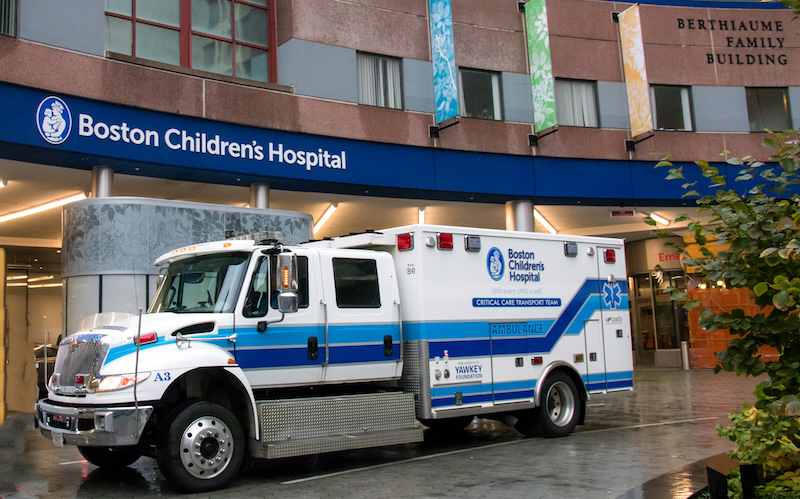My nursing story: Harriett Nelson

Harriett Nelson, CCRN, NRP, is a staff nurse III with the Critical Care Transport Team at Boston Children’s Hospital.
Before becoming a nurse on the Critical Care Transport Team (CCTT) in 2005, I was a bedside nurse in the Medical-Surgical ICU (MSICU), where I was introduced to palliative care. We all know that the doctors, nurses, and specialists at Boston Children’s Hospital are unsurpassed, but that there are still diagnoses that we can’t fix or cure, and children pass away. In the MSICU, I learned how to not only care for these children but also their families.
I was once asked to transport a baby with a terminal brain tumor home to be extubated in his home, surrounded by his family. It was an amazing experience. A few years later, I participated in my second palliative transport when the mom of a teen told the intensive care and Pediatric Advanced Care Team (PACT) teams that knew she would never be able to set foot in her house again if she did not bring her son home.
This was the beginning of my journey to facilitate the creation of a structured Pediatric Palliative Transport (PPT) program to provide a way to bring critically ill or terminally ill children home or to a hospice facility for end-of-life care. For as long as there has been a critical care transport team at Boston Children’s, there has been a way to take these children home from one of our ICUs if parents requested it. They were few and far between. But starting in 2014, it became a structured program, with an algorithm that gives each team tasks that need to be completed before the transport. The program formalized ICU and PACT teams’ discussions about whether they think transport is a good option for the family before presenting it to them as an option.

So why go home? When thinking of reasons to go home rather than stay in an ICU for end-of-life care, we have learned from patients and their families that there are a few overarching reasons. The first is about comfort: the comfort of the patient and the family, the comfort of being home in familiar surroundings, the comfort of having as many friends and family members there as you want to and the comfort of a quiet environment without the bells, whistles, and alarms of an ICU.
It facilitates the grieving process. It provides the parents with some control at a time when they may feel like they have none. And the last reason, which I feel is extremely important, is that there is no hurry. No other patient needs the room, and parents, family members, and friends don’t feel pressure. They can take their time saying goodbye, even after the patient passes.
The patient’s bedside team in the ICU, PACT, and the CCTT work together to make these transports happen. They are still relatively rare. Since 2007, we have done 24 transports. Most of these patients were inpatient in an ICU, and a few of these children were on an inpatient floor but were too complicated to be sent home in a regular ambulance without specially trained staff. This number may seem small, but the reality is that it is a big number when considered at a national level. These specialized pediatric transports are not common in our country, and there is a lack of published literature on the topic.
At Boston Children’s, we are contributing to this growing body of knowledge. We have published two papers and are in the process of conducting our second study.
I have been the principal investigator for both studies and have worked collaboratively with the Cardiovascular Critical Care nurse scientists who have mentored me through the research process.
Our latest study is called Exploring Interdisciplinary Team Members’ Perceptions of Taking Critically Ill Children Home or to a Hospice Facility as an Alternative End-of-Life Experience. It’s a sequel to our first study, Parents’ Experiences of Pediatric Palliative Transports: A Qualitative Case Series. We learned from that study that parents were very positive about the experience of bringing their child home from an ICU and strongly felt that the experience should be available to other parents in similar situations. In support of the parents’ request, we wrote an article describing the process of creating a structured procedure and standard method for providing pediatric palliative transports.
Pediatric palliative transports are unique and very little is published about them in the literature. I want to change that, and I believe that my research has, and will, continue to show the benefits of providing these transports. Pediatric Palliative Transports provide a way to increase the quality of life for critically ill children by providing them and their families a choice of location of death not commonly considered an option in an ICU setting. Although still a burgeoning practice, these special transports exemplify what I consider to be a true dedication to family-centered care.
Learn more about our Critical Care Transport Program.
Related Posts :
-

“Observe. Be open.”: How Boston Children’s nurses are changing the future of global health
Ashley Birch, MSN, CPNP, a Boston Children’s pediatric nurse practitioner and Global Nursing fellow, didn’t expect a trash ...
-

Nurse-led innovations: A virtual-nursing pilot helps nurses thrive
It was night shift on the 9E Inpatient Medical Unit and Marisol Hernandez, BSN, RN, CPN, was helping another nurse ...
-

In a thriving gene therapy program, nursing leadership is the driving force
Gene therapy was made possible by decades of technological advances. But to execute gene therapy at scale? That would not ...
-

‘The reason I became a nurse’: Maeve’s memories of laryngeal cleft repair
Being a gastroenterology nurse is more than a profession for Maeve Lee. When she cares for patients with feeding tubes, ...





